
Tibouchina Aubl. is a neotropical flowering plant genus in Melastomataceae Juss. that contains approximately 240 species. Species of this genus are herbs, shrubs or trees and typically have purple flowers. They are native to Mexico, the Caribbean, and South America where they are found as far south as northern Argentina. Members of this genus are known as glory bushes, glory trees or princess flowers. The name Tibouchina is adapted from a Guianan indigenous name for a member of this genus [2]. A recent systematic study has shown that this genus is paraphyletic.
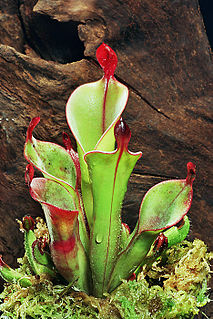
The genus Heliamphora contains 23 species of pitcher plants endemic to South America. The species are collectively known as sun pitchers, based on the mistaken notion that the heli of Heliamphora is from the Greek helios, meaning "sun". In fact, the name derives from helos, meaning marsh, so a more accurate translation of their scientific name would be marsh pitcher plants. Species in the genus Heliamphora are carnivorous plants that consist of a modified leaf form that is fused into a tubular shape. They have evolved mechanisms to attract, trap, and kill insects; and control the amount of water in the pitcher. At least one species produces its own proteolytic enzymes that allows it to digest its prey without the help of symbiotic bacteria.
Acanthella is a genus of two species of flowering plants in the family Melastomataceae. This genus is native to tropical South America.

Caryocar is a genus of flowering plants, in the South American family Caryocaraceae described as a genus by Linnaeus in 1771. It is native primarily to South America with a few species extending into Central America and the West Indies.

Heliamphora chimantensis is a species of marsh pitcher plant endemic to the Chimantá Massif in Venezuela. Specifically, it has been recorded from Apacará and Chimantá Tepuis. It is thought to be more closely related to the southern growing H. tatei and H. neblinae than to any of the other species found in the Gran Sabana and its tepuis. All other species known from this region have between 10 and 15 anthers, while H. tatei, H. neblinae and H. chimantensis have around 20. However, the anthers of H. tatei and the closely related H. neblinae are 7–9 mm long, while those of H. chimantensis only reach 5 mm in length.

Heliamphora pulchella is a species of marsh pitcher plant endemic to the Chimanta Massif and surrounding tepuis in Venezuela. It is one of the smallest species and closely related to H. minor.

Heliamphora tatei is a species of marsh pitcher plant endemic to Cerro Duida, Cerro Huachamacari and Cerro Marahuaca in Venezuela. It is closely related to H. macdonaldae, H. neblinae, and H. parva, and all three have in the past been considered forms or varieties of H. tatei. Like H. tatei, these species are noted for their stem-forming growth habit.

Aechmea tillandsioides is a bromeliad widespread across southern Mexico, Central America, and northern South America. It is widely cultivated in other regions as an ornamental plant. This plant is cited in Flora Brasiliensis by Carl Friedrich Philipp von Martius.
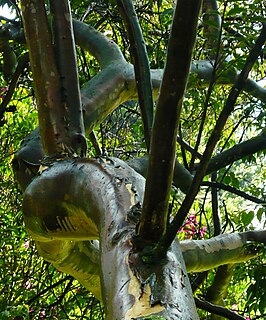
Calycolpus is a genus of the botanical family Myrtaceae, first described as a genus in 1856. It is native to the South America, Central America, and the West Indies.

Bonnetia is a genus of flowering plants in the family Bonnetiaceae. Most of the roughly 30 species are shrubs. The remaining species, all trees, are among the dominant species in the forest vegetation on the tepui plateaus of northern South America, such as B. roraimae on the summit of Mount Roraima.

Anthodiscus is a genus of plant in family Caryocaraceae described as a genus in 1818.
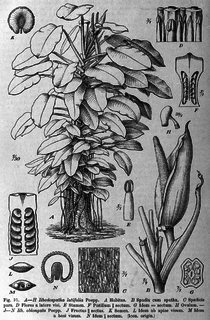
Rhodospatha is a genus of plant in family Araceae. It is native to South America, Central America, and southern Mexico.
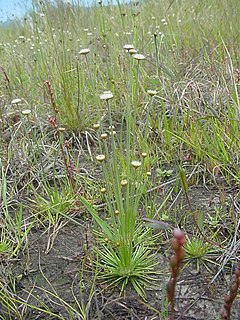
Syngonanthus is a genus of plant in family Eriocaulaceae. It is native to tropical Africa and to Latin America.
Heliamphora macdonaldae is a species of marsh pitcher plant endemic to Venezuela. It is closely related to H. tatei and was for a long time considered a form or variety of that species. Putative natural hybrids between H. macdonaldae and H. tatei have been recorded in the southern part of Cerro Duida.

Bixa is a genus of plants in the family Bixaceae. It is native to Mexico, Central America, Caribbean, and South America, and naturalized in other places.
Heliamphora ciliata is a species of Marsh Pitcher Plant endemic to Venezuela. It is restricted to a small number of swampy meadows in the uplands of Gran Sabana. In this habitat it is sympatric with a species of Stegolepis (Rapateaceae). Unusually for the genus, H. ciliata is a submontane plant, growing at an elevation of only 900 m.

Amasonia is a genus of plants in the family Lamiaceae, native to South America and to the island of Trinidad.
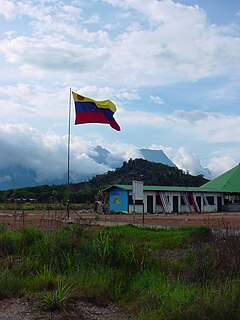
Cerro Duida, also known as Cerro Yennamadi, is a very large tepui in Amazonas state, Venezuela. It has an uneven and heavily inclined plateau, rising from highs of around 1,300–1,400 metres (4,300–4,600 ft) in the north and east to a maximum of 2,358 metres (7,736 ft) on its southwestern rim. It has a summit area of 1,089 km2 (420 sq mi) and an estimated slope area of 715 km2 (276 sq mi). At its foot lies the small settlement of La Esmeralda, from which the mountain can be climbed.
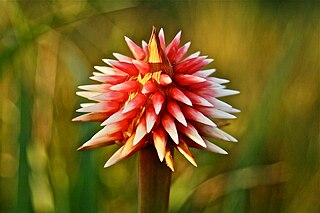
Guacamaya is a group of plants in the family Rapateaceae described as a genus in 1931.
Tateanthus is a genus of flowering plants belonging to the family Melastomataceae.














